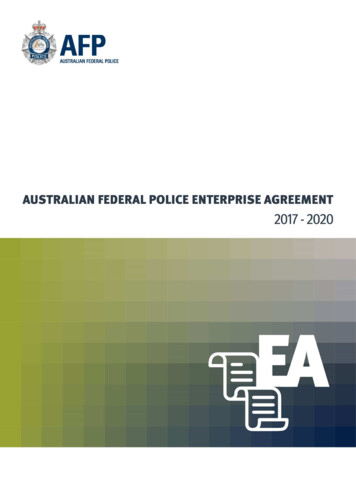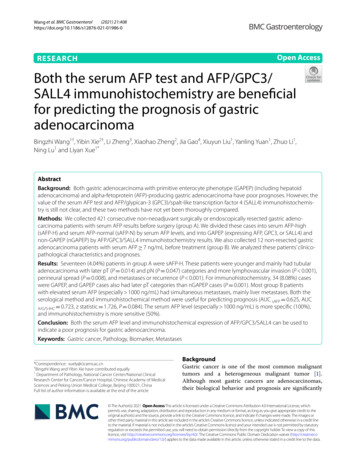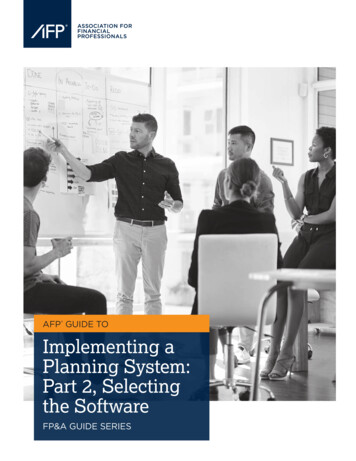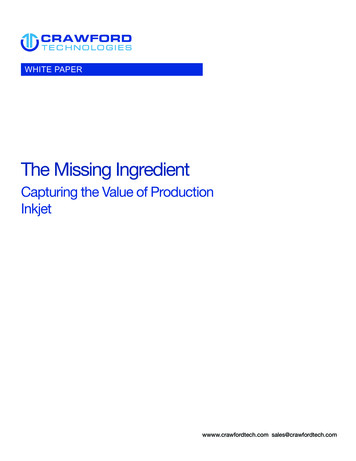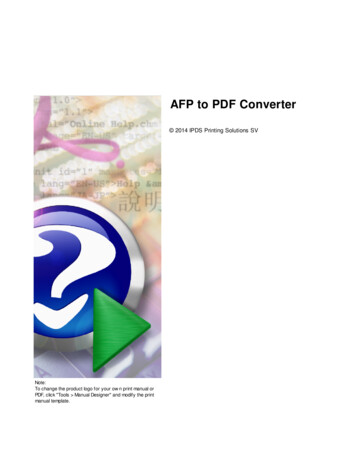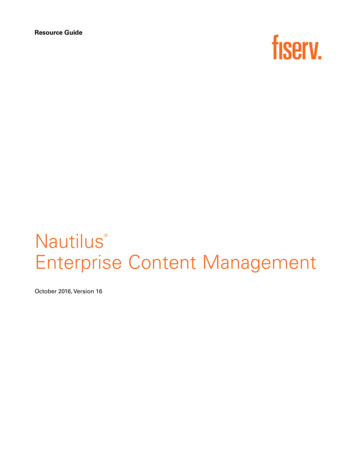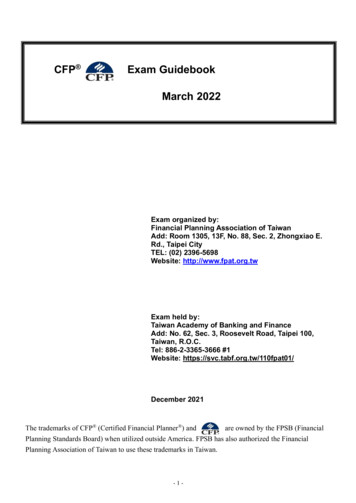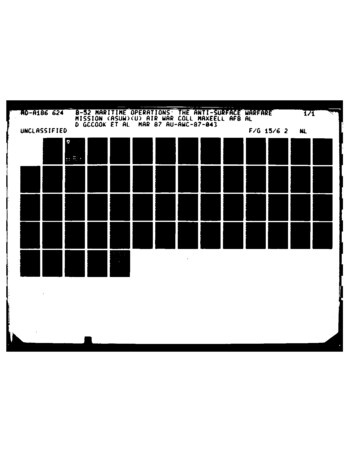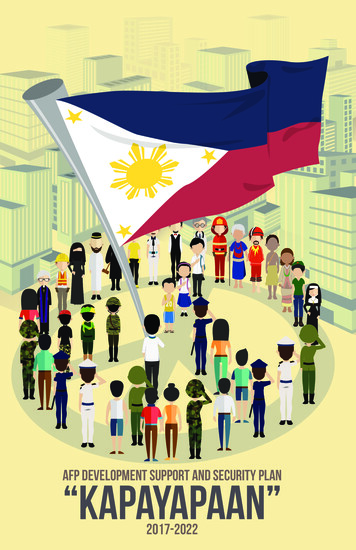
Transcription
AFP Development Support and Security Plan“Kapayapaan”2017-2022
TABLE OF CONTENTSAFP DEVELOPMENT SUPPORT AND SECURITY PLAN2017-2022ForewordPrefaceExecutive C ENVIRONMENT3.1Area of Operations/Interest3.2Challenges to Development and Security3.2.1 Governance3.2.2 Development3.2.3 Security3.3Development and Security StakeholdersNATIONAL STRATEGIC GUIDANCE4.1National Vision4.2Philippine Development Plan4.3National Security Policy4.4Peace and Development Agenda4.5National Defense Guidance and Policy ThrustsSTRATEGIC ASSUMPTIONSSTRATEGIC CONSIDERATIONSAFP MISSION – Development Support and SecurityAFP STRATEGY FOR DEVELOPMENT SUPPORT AND SECURITY8.1Strategic End-State8.2Strategic Approach8.3Strategic Imperatives8.4Strategic Concepts8.5Requirements for Development Support and SecurityCONCLUSIONAnnexesA. ReferencesB. GlossaryPage 2 of 56
Executive SummaryAFP Development Support and Security Plan 2017-2022The Armed Forces of the Philippines (AFP), as mandated by the 1987Philippine Constitution, is the protector of the people and the State. RA 8551 or thePNP Reform and Reorganization Act of 1998 placed the primary responsibility formatters involving the suppression of insurgency in the AFP.For decades, the country has been addressing insurgency using differentapproaches. These have provided the AFP with a degree of success, yet insurgencypersists up to the present day. Using the lessons gained from past campaigns, theAFP implemented the Internal Peace and Security Plan (IPSP) “Bayanihan” 20102016, focusing on “Winning the Peace” and the “whole-of-nation approach.” TheIPSP was people-centered and based on the understanding that the root causes ofinsurgency are complex and multi-dimensional requiring the involvement ofeveryone.Despite the government’s efforts, structural problems continue to exist,hampering effective governance and the delivery of basic services to thecommunities. More so, the country is burdened with peace and security problemssuch as criminality, corruption, terrorism, illegal drugs, proliferation of privatearmed groups, insurgency, and threats to territorial integrity.President Rodrigo Roa Duterte believes that “enduring peace can only beattained if the fundamental needs of every man, woman, and child will be met.”Thus, his administration’s thrusts center on compassion and radical changeencompassing the institutionalization of peace and order, ensuring inclusive socioeconomic growth and development, streamlining bureaucracy, and pursuing anindependent foreign policy.In support of the President’s vision, the AFP endeavors to adopt newstrategies in addressing peace and security. “Winning the Peace” has gainedsubstantial accomplishments for the past six years; thus, the AFP is now in thephase where it needs to “Sustain the Peace” while ensuring security, helpingmaintain public order, and significantly contributing to the development of thecommunities.With this, the AFP crafted this AFP Development Support and SecurityPlan 2017-2022. It adopts the Development-Governance-Security Framework as itsStrategic Approach, fully understanding the interdependent relationship and theintertwined linkages among development, governance and security issues. ThisPage 5 of 56
approach shall guide the AFP in performing its expanded role in sustaininginternal stability by ensuring that all military operations/activities are harmonizedwith and support the government’s reform programs to ensure good governance,sustainable development, social justice, and human security.At the outset, it is emphasized that this campaign plan is solely designed toaddress the internal threats to our national security. A separate plan is dedicatedto the territorial defense challenges and the protection of the sovereignty of ourcountry. Notwithstanding, the AFP DSSP 2017-2022, though focused on internalstability threats, likewise takes into consideration the transnational and globalinfluences affecting these threats.The Plan is an open document, available to the public. This underscores therole of the AFP as an active partner of the LGUs, government line agencies, andother stakeholders in different peace initiatives, socio-economic programs, civicworks, engineering projects, and other development-related activities. Its planningtimeframe is from CY 2017 to CY 2022. It is composed of the following sections:Background, Purpose, Strategic Environment, National Strategic Guidance,Strategic Assumptions, Strategic Considerations, the AFP Mission, AFP Strategyfor Development Support and Security, and the Conclusion.Central to the Plan are the challenges that significantly affect peace andsecurity. It underscores the political, legal, economic, socio-cultural, infrastructure,and informational challenges. The primary security threats that our country facesare the foreign and local terrorist groups (F/LTGs) like the Abu Sayyaf Group(ASG), Bangsamoro Islamic Freedom Fighters (BIFF), and Jemayah Islamiyah (JI).On the other hand, our country’s long standing battle with major insurgent armedgroups, specifically the MILF, MNLF, CPLA and the RPMP/RPA-ABB has taken anon-violent, friendly track as these groups have willingly discussed peace with thegovernment. In the spirit of the primacy of the peace process, this Plan thereforere-categorized these former threat groups as already Peace-Inclined ArmedGroups (PIAGs). This Plan, however, remains wary and prepared for armed peacespoilers that seek to derail the government’s peace agenda.Also, the Plan highlights areas of cooperation and convergence between theAFP and other stakeholders. The national government agencies and the LGUs playkey roles in the convergence approach of development, governance, and security.In a similar manner, the AFP has to ensure a secure environment to support all thegovernance and development initiatives. The NGOs, CSOs, academe, and religioussector can help bridge the gap in services to communities through communitybased development, technology, research, conflict resolution, informationcampaign, values education, and enabling mechanisms for mobilizing local,national, and international support for peace and reconciliation. Lastly the FilipinoPage 6 of 56
people, as the primary beneficiary of all these efforts have to be involved in theprocess.Under the Plan, the AFP’s mission is to conduct “development supportoperations” to sustain the peace, ensure security, and help maintain public orderso as to foster the foundation for inclusive economic and human development ofthe Filipinos.“Development Support Operations” is defined in this document as AFPoperations and activities conducted in support of civil authorities and otherstakeholders in promoting and sustaining internal stability to foster the foundationfor inclusive economic and human development of the Filipinos. It is focused onsupport for nation-building, support for law enforcement in the fight againstcriminality and illegal drugs, civil military cooperation, peacebuilding andadvocacy, and the application of military force against terrorists and other armedthreat groups.The AFP DSSP’s desired end-state is: terrorist groups and armed peacespoilers are defeated; conflicts with peace-inclined armed groups are resolved; anda secure environment is established to enable civil authorities to maintain publicorder and build the foundation for inclusive growth and a high-trust Philippinesociety. The Plan shall similarly pursue two imperatives: primacy of the peaceprocess in all operations and adherence to HR, IHL, and RoL.In its execution, the Plan highlights four strategic concepts: SustainedMilitary Operations to defeat terrorist groups and deter armed peace spoilers;Promotion of Peace; Active Support for Law Enforcement; and Contribution toNation-Building.To be able to accomplish all of these, the Plan identifies severalrequirements: the redeployment of forces to priority areas; the enhancement ofmilitary and non-military capabilities, such as peacebuilding, inter-agencycollaboration, stakeholders’ engagement, community development, doctrines onsupport for law enforcement, and sustaining the AFP’s Security Sector Reform(SSR) initiatives.The AFP DSSP 2017-2022 is the AFP’s contribution to the government’soverall efforts to attain stability, inclusive growth, and sustainable development inour country. The Plan focuses on the core competencies of the AFP and highlightsits various support roles in helping accomplish the peace and developmentprograms of the government.Page 7 of 56
1. BACKGROUNDThe Armed Forces of the Philippines (AFP) as mandated by the 1987Philippine Constitution is the protector of the people and the state. Traditionally,this refers to the protection from external aggression. Additionally, recent historyand situation has called for the involvement of the military in internal security.RA 8551 or the PNP Reform and Reorganization Act of 1998 placed the primaryresponsibility for matters involving the suppression of insurgency on the AFP.With the multi-faceted nature of the security environment, the AFPrecognized that a purely military solution is inadequate in addressing theprevailing security concerns, and that the concerted efforts from all stakeholdersare crucial in the attainment of sustainable and lasting peace. Thus, in 2010, itlaunched the Internal Peace and Security Plan (IPSP) “Bayanihan,” which wascentered on “Winning the Peace” through the whole-of-nation and the peoplecentered approaches. Basically, the Plan featured focused military operations andpeace and development efforts with the active involvement of all stakeholders andin adherence to the principles of Human Rights (HR), International HumanitarianLaw (IHL), and the Rule of Law (RoL).In the six years of its implementation, the AFP IPSP “Bayanihan” hasyielded significant results in the improvement of our country’s securityenvironment. Notably, it contributed to the declaration of 71 provinces as peacefuland ready for further development (PRFD) and providing a favorableenvironment for the realization of peace negotiations with the major insurgentarmed groups in the country. Through its adherence to the imperatives of HR, IHLand RoL and stakeholders' engagement, the AFP also gained the moral highground in its quest for lasting peace in the country.The current security environment shows that the AFP is on a strategictransition after more than four decades of addressing insurgency. With thePresident’s aspiration to have a “permanent and lasting peace,” the governmenthas laid down the roadmap for peace with all the major armed groups. However,the Philippines is still saddled by the violent activities of the ASG and otherterrorist groups and the menace of illegal drugs.Analysis of the security environment indicates that structural problemscontinue to exist which weaken institutions thereby affecting effective governanceand the delivery of basic services to the people and the communities. More so, thecountry is laden with other challenges that affect development and securityparticularly in the following spectrums: political, legal, economic, socio-cultural,infrastructure, and informational. Thus many communities are still vulnerable toPage 8 of 56
exploitation. Relatedly, policy incoherence, slow and inefficient justice system,inequitable distribution of wealth, perceived and existing social injustices, andunbalanced development between the rural and urban areas are among the mostexploited issues by insurgent armed groups. Likewise, terrorist groups are stillable to coerce local support in conflict-affected areas.Thus, in ensuring the security of the country, the President believes that“enduring peace can only be attained if the fundamental needs of every man,woman, and child will be met.” This centers on compassion (malasakit) and radicalchange (pagbabago), encompassing the establishment of peace and order, ensuringinclusive socio-economic growth and development, streamlining bureaucracy,and pursuing an independent foreign policy.Also, President Duterte signed Executive Order No. 5 on October 11, 2016adopting “Ambisyon Natin 2040” as the twenty-five-year long-term vision for thePhilippines. To ensure the continuity and consistency of strategies, policies,programs, and projects of the current and succeeding political administrations, itrequired all government departments, offices and instrumentalities, which includethe AFP and local government units (LGUs) to align their plans with the nationalvision.Consistent with this, the AFP formulated this AFP Development Supportand Security Plan 2017-2022 to support the attainment of the national developmentand security goals of the country in the medium term towards realizing thenational vision. This campaign also implements the President’s aspiration ofattaining “permanent and lasting peace” before his term ends. The Plan calls forthe primacy of peace process in all AFP operations and activities, and sustains thetried and tested approaches and imperatives of previous AFP Plans.A significant feature of the Plan is the adoption of the DevelopmentGovernance-Security framework as its main strategic approach. It means that theAFP’s operations and activities shall be harmonized with the efforts of otherstakeholders in the context of a shared understanding of the linkages betweendevelopment, governance, and security issues in the affected communities. Thisapproach focuses on ending the armed struggles through reforms, achievingsustainable development, social justice, and human security.The Plan is a product of the collaboration of stakeholders from the differentgovernment agencies, CSOs, and the academe. The active participation andmeaningful contribution of partner-stakeholders became the foundation of thesuccessful formulation of this new AFP Plan.Page 9 of 56
2. PURPOSEThe AFP Development Support and Security Plan 2017-2022 is a broad planthat shall guide the AFP in promoting peace, ensuring security, helping maintainpublic order, and supporting the overall development initiatives of thegovernment towards inclusive growth. Anchored on national strategic guidance(National Vision, National Security Policy, Philippine Development Plan, NationalPeace and Development Agenda, and the Department of National DefenseGuidance and Policy Thrusts), the AFP DSSP 2017-2022 is the AFP’s approach inhelping translate the national government’s goals into reality.The Plan shall guide the unified commands (UCs), major services (MS), andAFP-Wide Support and Separate Units (AFPWSSUs) in planning for andcontributing to the attainment of internal stability for the next six years.The Plan is also an open document and shall be available to all stakeholdersin the interest of transparency, institutionalizing collaboration and support fromthe broadest spectrum of stakeholders. The AFP DSSP 2017-2022 puts emphasis onthe convergence of all the development, governance, and security efforts to achievepeace and promote the national well-being of the Filipino people. It recognizes thatsecurity should be an integral part of national development and good governance,in order to help foster the foundation for inclusive economic and humandevelopment of the Filipino people.Page 10 of 56
3. STRATEGIC ENVIRONMENT3.1. Area of Operations and InterestThe Philippine territory comprises the Philippine archipelago, with all theislands and waters embraced therein, and all other territories over which thePhilippines has sovereignty or jurisdiction, consisting of its terrestrial, fluvial, andaerial domains, including its territorial seas, the seabed, the subsoil, the insularshelves, and dimensions which form part of the internal waters of the Philippines.The geographic configuration and location of the country poses a myriad ofchallenges and opportunities ranging from security, cultural, economic, political,and environmental issues. The waters that link and separate the country’s islandsact as both conduits and barriers to lines of communications. In the aspect ofsecurity, these conditions create an inherently complex operating environmentthat requires the deployment of considerable military resources. The openness ofthe country’s borders has made the Philippines a transit point for transnationalthreats such as terrorism, international crime syndicates, piracy, and human andillegal drug trafficking.This Plan likewise acknowledges that the development and securitysituation of the country is affected by other external actors and organizations.These include the Asia-Pacific Region, countries with conglomeration of FilipinoNationals, as well as foreign states and organizations. The worsening securitysituation caused by terror attacks and stricter imposition of immigration laws byother countries remains a security concern of the Overseas Filipino Workers(OFWs) around the world.3.2. Significant Challenges to Development and Security3.2.1. Governance Challenges3.2.1.1. PoliticalThe country’s political environment is beset by problems that run deepin the structure of the system. It is characterized by the monopoly of power bypolitical dynasties, warlordism in isolated areas, and selfish interests of a fewprevailing over the common good. There are also institutional concerns thatPage 11 of 56
unwittingly contribute to the problems of the country. Policy incoherence both onthe strategic and the domestic levels continue to challenge the operations ofgovernment agencies. As a consequence, the development and security situationof the country is affected.On a positive note, we now have a strong-willed leadership at thenational level; the President is bent on instituting reforms for the well-being of thepeople. The current efforts of the government includes the elimination ofcorruption both in the high and the low echelons of government.3.2.1.2. LegalThe legal environment is characterized by the presence of robust lawsbut a seemingly slow and inefficient implementation system. The slowdispensation of justice, perception of favoring the rich and powerful, and poorpenal system cause people to sometimes rely on extra-legal means of retributionand restitution. The lack of legal assistance to duty bearers also affects the lawenforcement functions and serves as legal constraint for law enforcement agencies(LEAs).Allegations of HR violations by the AFP is also among the issues beingraised by critics. However, it must be noted that the strict adherence to HR, IHL,and RoL by the military has been institutionalized under IPSP “Bayanihan” andare now firmly embedded in the doctrines and tactic, techniques and procedures(TTPs) of the AFP, and the AFP Transformation Roadmap.3.2.2. Development Challenges3.2.2.1. EconomicThe Philippine economic environment is characterized by inequitabledistribution of wealth and unequal access to economic opportunities. ThePhilippines is experiencing fast GDP growth, but economic benefits do not tricklefast enough for the poorer sector of society to enjoy. Poverty rate remains above20% across regions. Recent positive developments in our economy are still hardlyfelt by the majority of the population as the immediate benefits are concentratedin the urban areas. There likewise remains a wide income gap between socialclasses which breeds discontent and provides exploitable issues for insurgency.Page 12 of 56
3.2.2.2. Socio-CulturalNational identity remains a major challenge for the Philippine society.The weak identification with a common national Filipino identity is largely due tothe presence of strong ethno-nationalist identities among the 110 ethno-linguisticgroups populating the country. This further contributes to the divisions that isalready caused by the economic and geographical divides of the people.Similarly, colonial influences, high population growth, and perceivedand actual discrimination and social injustices (Moro, indigenous people, andlower classes of the society) contribute to a weak national cohesiveness andexacerbate social tension. Demographic factors also affect the attainment ofdevelopment and security. Rapid population growth aggravates prevailing socialtensions as the former places greater strain on already scarce resources.3.2.2.3. InfrastructureThe unbalanced development between the rural and urban centersremains an issue in the country. Development, especially the construction ofcritical infrastructure, is still concentrated in urban areas. Transportation andcommunication infrastructure in the rural areas are still underdeveloped. Thisnegatively impacts the economic growth and progress of majority of themunicipalities. This situation is worsened as the armed threat groups’ exploit theseissues to further their own agenda and interests.The slow development in the countryside has further led to thecongestion in the urban areas, particularly in Metro Manila, where the trafficproblem has cost the country billions of lost productivity.3.2.2.4. InformationalWhile the information sector can serve as an enabler of economicdevelopment, the current informational environment lags behind in contributingto economic development. The informational environment in the ionandcyber-attacks. Significantly, majority of the media companies are owned andcontrolled by the economic and political elite, such that the narrative may beinfluenced by political and personal interests. In addition, the Philippines has oneof the slowest internet connection in Asia. Needless to say, the information andPage 13 of 56
communication sector is still in the process of catching up with the more advancedstates in Asia.3.2.3. Security Challenges3.2.3.1. Internal Stability3.2.3.1.1. Peace-Inclined Armed Groups (PIAGs)In full support of the Peace Agenda of the government, the AFPoffers this re-categorization to refer to all the major insurgent armed groups thathave now entered into a peace agreement or are currently in peace negotiationswith the government.3.2.3.1.1.1. Moro Islamic Liberation Front (MILF)The MILF finalized its peace accord with thegovernment with the signing of the Comprehensive Agreement for theBangsamoro (CAB) on March 27, 2014. The non-passage of the Bangsamoro BasicLaw (BBL) which is the translation of the CAB provisions into law has created aprevailing tense situation. Notably the ceasefire between the government and theMILF forces remains in place and the creation by the President of theImplementing Panel to push the implementation of the provisions of the CAB thatare not tied to the passing of a law has eased the tensions and provided an avenuefor the resumption of the peace programs that have been agreed upon between theGovernment and the MILF. What is not discounted, however, is the threat of peacespoilers, such as the BIFF taking advantage of the current situation to try todestabilize the peace initiatives and draw some of the MILF armed groups back toviolence and the secessionist movement.3.2.3.1.1.2. Moro National Liberation Front (MNLF)The MNLF signed the Final Peace Agreement (FPA)with the government on September 2, 1996. Most of the mainstream MNLF forceshave been reintegrated into Philippine Society while a few groups under theleadership of former MNLF Chairman Nur Misuari went rogue and resumedfighting with the government. The primary point of contention apparently is thenon-implementation of some of the provisions in the 1996 FPA. However, thecurrent dialogues between the government and Nur Misuari is a welcomePage 14 of 56
development, especially that a government panel has been created to look into andresolve the remaining political obligations stipulated in the 1996 FPA. The RogueMNLF elements remain a security concern as they are still predisposed to violenceas their way of making political statements, exemplified by the Zamboanga Citysiege last September 2013. Moreover, some Rogue MNLF members are suspectedto have links to the ASG and other local terrorist groups.3.2.3.1.1.3. Cordillera People’s Liberation Army(CPLA)After its split from the CPP-NPA-NDF in April 1986,the CPLA went on their own and pushed for the autonomy of the Cordilleras. Thepeace accord with the CPLA in September 1986 resulted in the signing of a jointMemorandum of Agreement (MOA) on cessation of hostilities known as theMount Data Accord. Subsequently, President Corazon Aquino signed ExecutiveOrder (EO) 220 creating the Cordillera Administrative Region (CAR) on July 15,1987. To date, the parties have delivered their respective commitments (i.e. turnin of firearms, integration of some CPLA members to the AFP, and peace anddevelopment interventions in CPLA Manggagawa ng Pilipinas/Revolutionary Proletarian Army-Alex BoncayaoBrigade (RPM-P/RPA-ABB)A break-away group of the mainstream CPP-NPANDF, the RPM-P/RPA-ABB, was formed in 1993. In 2000, a peace agreementbetween the government and the group was signed. However, due to the rift inthe organization, only the TABARA-PADUANO Group (TPG) moved forwardwith the peace agreement and transformed into a legal entity presently known asthe Kapatiran para sa Progresong Panlipunan (KPP) while the Nilo DELA CRUZGroup (NDCG) has yet to discuss frameworks and proposals with the gagawa-Mindanao/Revolutionary Peoples’ Army (RPMM-RPA)ngThe RPMM-RPA was founded on May 1, 2001 as aproduct of a series of splits from the mainstream CPP-NPA-NDF in September1994 and the RPM-P/RPA-ABB in March 2001. The group also came to be knownas the Central Mindanao Region (CMR) Rejectionist Group. Currently, it is havingcommunity-based and people-centered peace talks with the government.Page 15 of 56
3.2.3.1.1.6. Marxist-Leninist Party of the Philippines- Rebolusyonaryong Hukbong Bayan (MLPP-RHB)The MLPP-RHB, based mainly in Central Luzon, wasalso a product of the split within the CPP in the early 1990s. It figured in armedskirmishes with the NPA in its areas of operation. However, it degenerated into acriminal group engaged in gun-for-hire and extortion activities.3.2.3.1.2. CPP-NPA.-NDFThe Communist Party of the Philippines – NewPeople’s Army – National Democratic Front (CPP-NPA-NDF) remains a primarysecurity challenge mainly because of its nationwide affectation of areas. Itsintention to resume formal peace negotiations with the government is surely apositive development in the security situation. However, its continued antigovernment propaganda efforts, armed extortion activities, and publicpronouncements of continuing the armed struggle have to be given significantattention so as to provide appropriate safeguards to protect the government andthe people and ensure the internal stability of the country. The CPP-NPA-NDF hasnot yet renounced its aim to supplant the country’s democracy with a totalitariancommunist state, primarily by waging a protracted war against the government. Ithas continued to establish linkages with local and international organizations forsupport.3.2.3.1.3. Terrorist Groups3.2.3.1.3.1. Abu Sayyaf Group (ASG)Formed in the early 1990s, the ASG’s objective is toestablish an independent theocratic Islamic society in Mindanao. Following theneutralization of key leaders, the ASG lost its central leadership and evolved intoseveral mutually supportive semi-autonomous sub-groups, mainly based in Suluand Basilan. The ASG conducts harassment and IED attacks against governmenttroops. Kidnap-for-ransom (KFR) remains as the ASG’s primary source of funds.The ASG’s strength is attributed to its support network, built on kinship ties andinter-marriages, alliances with other local armed threat groups, linkages with localpoliticians, and ties with foreign terrorists (FTs).Page 16 of 56
3.2.3.1.3.2. Bangsamoro Islamic Freedom Fighters(BIFF)The BIFF separated from the MILF in 2011 with theobjective of establishing an Islamic State in Mindanao. The group is capable ofconducting small-scale atrocities and bombing operations targeting governmentforces as well as key cities and Christian-populated areas in Central Mindanao.The strength of the group is attributed to the support network from relatives,sympathizers, and former comrades from other MILF Base Commands. Further,the group is known to coddle foreign terrorists in its lairs for indoctrination andtraining for its gradual alignment with DAESH ideology and objectives.3.2.3.1.3.3. Other Local Terrorist Groups (LTGs)3.2.3.1.3.3.1. LTG MauteThe Maute Group, based in Lanao del Sur,seeks to be recognized locally and internationally as a jihadist group. The groupgained prominence in February 2016 after it launched atrocities againstgovernment forces and civilians, triggering a series of military operations thatresulted in the neutralization of several members and supporters. The grouppledged allegiance to the Islamic State in Iraq or Syria (ISIS) or es (AKP)The group was established in 2013 andswore allegiance to DAESH in August 2014. The group’s goal is to establish anIslamic caliphate through violent jihad and implementation of the shariah bysecuring external support and recruiting from other terrorist groups in Mindanao.LTG-AKP operates in Sultan Kudarat and Sarangani and is largely influenced byIndonesian jihadist groups.1Arabic acronym meaning Dawla al-Islamiya Fi Iraq Wa al-Sham or Islamic State of Iraq and the Levant),which IS militants do not favor because it is similar to the Arabic words ‘Daes,’ one who crushes somethingunderfoot; and, ‘Dahes,’ translated as one who sows discord.Page 17 of 56
3.2.3.1.3.4. Foreign Terrorist GroupsForeign terrorists (FTs) in the country are members of theJemaah Islamiyah (JI) and other terrorist organizations in neighboring countries orforeign nationals inspired by DAESH. Their presence is a major security threatbecause of the propagation of extremist teachings, transfer of knowledge
AFP DEVELOPMENT SUPPORT AND SECURITY PLAN 2017-2022 Foreword Preface Executive Summary 1. BACKGROUND 2. PURPOSE 3. STRATEGIC ENVIRONMENT 3.1 Area of Operations/Interest 3.2 Challenges to Development and Security 3.2.1 Governance 3.2.2 Development 3.2.3 Security 3.3 Development and Security Stakeholders 4. NATIONAL STRATEGIC GUIDANCE

